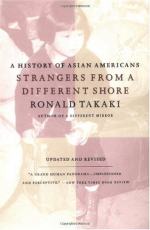
|
| Name: _________________________ | Period: ___________________ |
This test consists of 15 multiple choice questions and 5 short answer questions.
Multiple Choice Questions
1. What were the Indian immigrants attempting to escape in India?
(a) British rule.
(b) The education system.
(c) Genocide.
(d) War.
2. What valley did the author grow up in?
(a) Valley Gorge.
(b) Annapolis Valley.
(c) Palolo Valley.
(d) San Fernando Valley.
3. What location became the prime meeting spot for Chinese immigrants?
(a) Restaraunts.
(b) Shopping malls.
(c) Laundromats.
(d) Stores.
4. Where did Takaki go to college?
(a) The East coast.
(b) The West coast.
(c) The South.
(d) The Midwest.
5. What caused the strike with the Central Pacific Railroad to end?
(a) Central Pacific Railroad went bankrupt.
(b) The Central Pacific Railroad threatened to hire black men instead.
(c) The Chinese people found a better company to work for.
(d) An agreement was reached.
6. What made Chinese immigrants a threat to the mining industry?
(a) Their long hair.
(b) Their pointy shoes.
(c) Their culture.
(d) Their theivery.
7. After the mining industry turned their back on the Chinese, what industry did they turn to?
(a) Industrial.
(b) Farming.
(c) Financial.
(d) Marketing.
8. Why did Hawaiian planters begin to hire nationalities other then Chinese?
(a) To keep unions out.
(b) The Chinese immigration rates decreased.
(c) Other people applied for the job.
(d) There was a strike.
9. Where did Japanese immigrants believe they would end up living after a few years of work?
(a) Alaska.
(b) Japan.
(c) Hawaii.
(d) Maryland.
10. Which policy worker called for the use of Chinese workers on the transcontinental railroad?
(a) Aaron H. Palmer.
(b) George Frank.
(c) James F. Kennedy.
(d) William Clinton.
11. Why did Chinese immigrants begin to open laundromats?
(a) The initial capital was low.
(b) Familes could run the buisness.
(c) There was a great need for the service.
(d) They were fired from the railroad.
12. Who did William Hoper find to be productive workers?
(a) Brazilian immigrants.
(b) Women.
(c) Chinese immigrants.
(d) Polish immigrants
13. In Chapter 3, where does Takaki write that many Chinese immigrants settled?
(a) Kentucky.
(b) New York.
(c) California.
(d) Maryland.
14. Why did the Japanese limit Korean immigration to Hawaii, according to Chapter 2?
(a) So they could not compete with the Japense for jobs.
(b) The quota was already met.
(c) Korea went to war.
(d) Hawaii decided to build a really big fence.
15. What was the purpose of the taxes that were imposed on immigrants, according to Takaki?
(a) Law and order.
(b) Revenue.
(c) All citizens should be taxed.
(d) Exclusion of the Chinese.
Short Answer Questions
1. What were blood unions based upon?
2. Who did the foreign miners' license tax apply to?
3. In what year was a law passed that prohibited Japanese from owning land?
4. How many Asians arrived in Hawaii between 1850 and 1920?
5. What types of businesses did Japanese immigrants open?
|
This section contains 425 words (approx. 2 pages at 300 words per page) |

|




